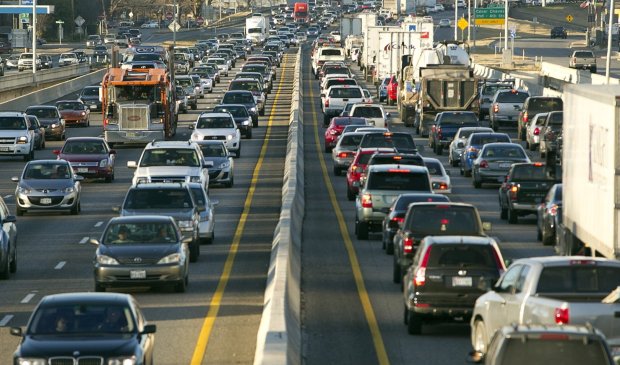TxDOT data shows congestion on Austin roads
Monday, September 29, 2014 by
Mark Richardson New figures released by the Texas Department of Transportation quantify what anyone who drives in the Austin area instinctively knows – traffic congestion on several local roads and highways is as bad as anywhere in the state and getting worse.
One stretch, Interstate 35 through downtown between the U.S. 290 intersection and Lady Bird Lake, ranks as the second-most congested roadway segment in the entire state, and ranks first in freight-related congestion. Ten other Austin-area roadways are among the worst 100 in the state.
TxDOT recently released the 2014 Most Congested Roadways in Texas, with numbers updated from 2013. The data comes from the Texas A&M Transportation Institute, which uses roadway inventory and traffic volume information from TxDOT along with speed data from INRIX, a private-sector source of traffic data. The complete list is available on the TxDOT website.
“I don’t think I have to tell anyone that traffic in Austin is extremely congested, and with the current amount of expenditures, it is only going to get worse,” said Kelli Reyna, public information officers for TxDOT’s Austin region. “We know we can’t just build our way out of this. It’s going to take some innovative thinking to begin solving the congestion problem.”
The numbers are meaningful to Austin, which is putting a $1 billion transportation bond in the Nov. 4 ballot. The bond includes $600 million toward constructing a 9.5-mile urban rail line, along with another $400 million for unspecified a package of local road projects.
In the 2014 listings, traffic on Austin’s I-35 central city segment took an average of 2.54 times the normal traffic flow time to travel the roadway. Commuters on that stretch experienced more than 950,000 hours of delays per mile during the past year, and commercial trucks – for whom time is money – endured more than 116,000 hours of delays coming through central Austin.
According to TxDOT, the worst road in Texas is a segment of Loop 610 in Harris County, with 1.2 million hours of delays costing the Houston area $81 million a year.
Perhaps the most telling statistic about traffic congestion in the I-35 corridor is that it costs the Austin economy some $196 million a year, and is costing the commercial trucking industry another $72 million in lost transit time.
Other roadways in the Austin area on the list (and their rank) include:
- 25th – MoPac Expressway (US 183 to Loop 360), which has 344,000 hours of delays per mile and costs Austin almost $75 million a year;
- 35th – Interstate 35 (SH 71 to Slaughter Lane), 274,000 hours of delays per mile and $36 million;
- 47st – South Lamar Boulevard (West Cesar Chavez to US 290), 208,000 hours of delays per mile and $17 million;
- 53rd – South Congress Avenue (11th Street to Ben White Boulevard), 201,000 hours of delays per mile and $16 million;
- 57th – Interstate 35 (Parmer Lane to US 290 North), 196,000 hours of delays per mile and $32 million;
- 66th – West Slaughter Lane (Brodie Lane to I-35), 188,000 hours of delays per mile and $15 million;
- 80th – Guadalupe Street (North Lamar Boulevard to West Cesar Chavez), 171,000 hours of delays and $14 million;
- 82nd — North Lamar Boulevard (US 183 to West 45th Street), 165,000 hours of delays per mile and $10 million;
- 98th – Loop 360 (RM 2244 to US 290), 156,000 hours of delays per mile and $16 million; and
- 99th – South First Street (Cesar Chavez to Ben White Boulevard), 155,000 hours of delays per mile and $10 million.
The Texas A&M Transportation Institute ranked delays on each roadway on three different scales:
- The Texas Congestion Index, the ratio of the peak period average travel time to the free-flow travel time;
- The Planning Time Index, the ratio of the 95th percent peak period travel time to the free-flow travel time; and
- The Commuter Stress Index, the same as the TCI, except it measures only the peak direction of travel.
Traffic on most of the Austin roadways in the list ranked at or near the top of all three scales.
(This story was updated Sept. 29 to clarify that $400 million of Austin’s $1 billion Nov. 4 ballot proposition is for a specific package of roadway projects and that delay times shown for each road segment are for each mile of specified roadway.)
You're a community leader
And we’re honored you look to us for serious, in-depth news. You know a strong community needs local and dedicated watchdog reporting. We’re here for you and that won’t change. Now will you take the powerful next step and support our nonprofit news organization?







